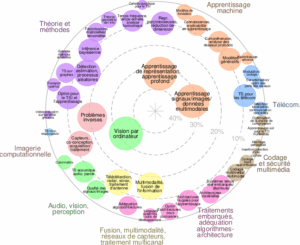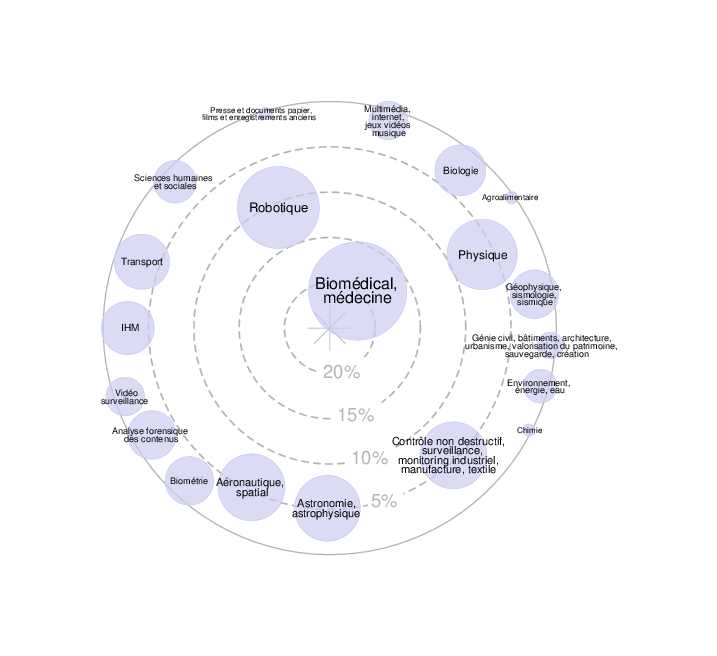Keywords: radio astronomy, interferometry, manifold, statistical signal processing.
PDF version : https://www.cyrilcano.fr/home/intership
Scientific context
Modern radio telescopes enable high-resolution imaging of astrophysical objects from interferometric measurements. A radio telescope, such as the Very Large Array [5], consists of an array of antennas spaced up to several kilometers apart — or even thousands of kilometers in the case of the Event Horizon Telescope [7]. The measurements collected by these instruments are intercorrelations between the signals received by the different antennas and can be modelled as covariance matrices. It can be shown that these measurements allow sampling of the Fourier transform of the source of interest [3]. Based on this principle, modern techniques for reconstructing astrophysical images are mainly based on regularized maximum likelihood approaches [6] or parametric decomposition algorithms [4].
Depending on the nature of the source, several approaches can be considered. Observed astrophysical sources fall into three categories: static (e.g., a group of stars), dynamic (e.g., an accretion disk around a black hole), or transient (e.g., a fast radio burst). In this internship, we focus particularly on static and dynamic sources. Our goal is to develop a new dynamic reconstruction method of the source power that incorporates a physical model describing its evolution. From this, the observed image can be reconstructed.
Recently, a new approach has been proposed, based on a non-standard, misspecified Kalman filter [1]. This approach notably extends the applicability of the Kalman filter to situations where the measurement models are unknown or only partially known. It considers only uncorrelated sources, which allows the formulation of an observation model in the non-asymptotic case, from which the Kalman framework is developed. Noise is modeled directly at the level of the signal received by each antenna, and the functional being optimized is the mean squared error between the true source powers and their estimators.
Objectives
This internship aims to carry out both theoretical and simulation work to bridge two approaches: (i) the dynamic estimation of source power based on a misspecified Kalman filter [1], and (ii) filtering methods on manifolds that operate directly in the space of covariance matrices, i.e., on a manifold [2]. The advantage to use this modelling is to constraint to estimate covariance matrix by conserving its properties. In particular, formalizing the filter directly in the space of covariance matrices would allow us to address cases where the sources are correlated and to preserve the covariance structure of the observations. Thanks to a new modeling of the observation process, this new framework could reduce the estimation error — thereby improving the performance of the method — and enhance the resolution of the reconstructed image.
Work Plan:
– First, the recruited candidate will become familiar with the formalism and the existing code implemented within the framework of the first approach [1].
– Next, he/she will study filtering methods on manifolds [2] and review the existing working notes.
– Finally, he/she will complete the formalization of the new filter and test it on simulated data.
General informations
- Disciplines: statistical signal processing, recursive estimation, Kalman filtering theory.
- Tools: MATLAB.
- Required curriculum: MSc. or Dipl. Ing. in applied mathematics, computer science or
statistics. - Duration: 5 to 6 months.
- Starting date: February to Early April 2026.
- Applications (CV, motivation letter, recommandation letter) and informal inquiries are to
be e-mailed to Samy Labsir (Associate Professor, IPSA/TéSA), samy.labsir@ipsa.fr and
Cyril Cano , cyril.cano@ecole-air.fr, (Associate Professor, ´Ecole de l’air et de l’espace). - Location: TéSA laboratory, Toulouse, France, in a quiet, sunny environment close
to the Canal du Midi. - Salary: ∼ 600 to 700 euros /Month with better quality of life than Paris.
Hosting structure
IPSA, school of aeronautics and space, is to train for all engineering professions in the aerospace and sustainable mobility sectors. IPSA offers an engineering curriculum and a Bachelor’s degree in aeronautics on its two campuses in Paris, Toulouse and Lyon.
The Signals and Artificial Intelligence (SIA) research team at IPSA focuses on signal processing, telecommunications, and their numerous applications in complex embedded systems. At the intersection of statistical signal processing, artificial intelligence, and robotics, the team develops innovative methods to model, diagnose, and optimize critical systems in fields such as aerospace, space, automotive, and healthcare.
References
[1] C. Cano, M. N. El Korso, É. Chaumette, P. Larzabal, Kalman filter for dynamic source power and steering vector estimation based on empirical covariances, Signal Processing, Volume 230, 2025, 109868, ISSN 0165-1684, https://doi.org/10.1016/j.sigpro.2024.109868.
[2] G. Bourmaud, R. Mégret, A. Giremus and Y. Berthoumieu, ”Discrete Extended Kalman Filter on Lie groups,” 21st European Signal Processing Conference (EUSIPCO 2013), Marrakech, Morocco, 2013, pp. 1-5.
[3] van der Veen, AJ., Wijnholds, S.J., Sardarabadi, A.M. (2019). Signal Processing for Radio Astronomy. In: Bhattacharyya, S., Deprettere, E., Leupers, R., Takala, J. (eds) Handbook of Signal Processing Systems. Springer, Cham. https://doi.org/10.1007/978-3-319-91734-4_9
[4] Högbom, J. A. ”Aperture synthesis with a non-regular distribution of interferometer baselines.” Astronomy and Astrophysics Supplement, Vol. 15, p. 417 15 (1974): 417.
[5] P. J. Napier, A. R. Thompson and R. D. Ekers, ”The very large array: Design and performance of a modern synthesis radio telescope,” in Proceedings of the IEEE, vol. 71, no. 11, pp. 1295-1320, Nov. 1983, doi: 10.1109/PROC.1983.12765.,
[6] Y. Mhiri, M.N. El Korso, A. Breloy, P. Larzabal, Regularized maximum likelihood estimation for radio interferometric imaging in the presence of radiofrequency interferences, Signal Processing, Volume 220, 2024, 109430, ISSN 0165-1684, https://doi.org/10.1016/j.sigpro.2024.109430.
[7] Event Horizon Telescope Collaboration. (2019). First M87 event horizon telescope results. IV. Imaging the central supermassive black hole. https://doi.org/10.3847/2041-8213/ab0e85





